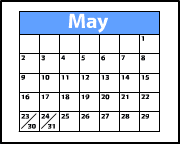
Last week, the
National PTA recognized seven schools with it annual Phoebe Apperson Hearst Family-School Partnerships Awards. The awards recognize school PTAs that put strong practices into place to involve parents and families into the lives of their schools.
This year’s Outstanding Family-School Partnership Award went to
Kate Waller Barrett Elementary School in Arlington, Virginia. Barrett’s PTA will use the award’s $2,000 cash prize to expand Roving Readers, its school-wide literacy program. Roving Readers is a diverse group of parents and neighbors who serve as guest readers and storytellers in the school.
“We are thrilled that our PTA was recognized with the Phoebe Apperson Hearst Family-School Partnership award,” said Principal Terry Bratt. “Our parent group has been an extremely supportive partner and has provided us with a number of resources through its fundraising efforts…. There is no doubt that our students want to come to school every day because of the activities and programs we have in place.”
Six runners-up represent outstanding efforts in implementing each of the PTA’s six
National Standards for Family-School Partnerships. Those standards, and the schools that were recognized, are
● Standard 1: Welcoming all families into the school community
Chattachhoochee High School, Alpharetta, Georgia;
● Standard 2: Communicating effectively
Olivewood Elementary School, Lake Forest, California
● Standard 3: Supporting student success
Chapel Trail Elementary School, Pembroke Pines, Florida
● Standard 4: Speaking up for every child
Seven Oaks Elementary School, Eagle, Idaho
● Standard 5: Sharing power
Harmony Elementary School, Goshen, Kentucky
● Standard 6: Collaborating with the community
Northeast Elementary School, Evergreen Park, Illinois
TEN TRUTHS ABOUT PARENT INVOLVEMENTThe research is clear and convincing: Regardless of income or background, when parents are involved, students are more likely to earn higher grades and test scores, enroll in higher-level programs, attend school regularly, have better social skills, show improved behavior, graduate, and go on to postsecondary education. Here are 10 more truths about parent involvement from the National PTA.
1. All parents have hopes and goals for their children.
2. Parents differ in their abilities and/or resources to help their children
reach those goals.
3. The parent is the central contributor to a child’s education.
4. Parent involvement must be seen as a legitimate element of education
and deserves equal emphasis with elements such as school
improvement and evaluation.
5. Parent involvement is an ongoing process, not a series of events.
6. Parent involvement requires a shared vision, policy, and
framework for planning programs and practices that are
connected to student learning.
7. Many barriers to parent involvement are found within school
practices, attitudes, and assumptions.
8. Successful parent involvement programs help families guide their
children’s learning from preschool through high school.
9. Families from diverse backgrounds have their own set of norms
and experiences that often influence their relationship with
schools.
10. Parents are more likely to become involved when they understand
that they should be involved; they feel capable of making a
contribution; and they feel invited by the school and their
children.
ADDITIONAL RESOURCES FROM THE NATIONAL PTAFamily-School PartnershipsWhen families, schools, and communities work together, student achievement improves, teacher morale rises, communication increases, and family, school, and community connections multiply.
PTA National Standards Implementation GuideThis guide serves as a tool for empowering people to work together with an end goal of building family-school partnerships and student success.
PTA Great Idea BankThis social network enables parents to interact and learn from each other how to overcome the challenges of parenting today.
PARENT INVOLVEMENT RESOURCES FROM EDUCATION WORLDParent Involvement in SchoolsLearn about practical ways in which schools are involving parents. Read about parent involvement strategies that are working for others -- and that could work for you.
Partners for Student SuccessMany schools or districts are taking unique approaches to bringing together schools with their parents and community to help ensure student achievement. Articles in this series are based on the work of the National Network of Partnership Schools at Johns Hopkins University.
Fundraising Ideas for SchoolsThe articles in this Education World archive share practical fundraising ideas that are working in schools around the world. If you’re looking for fun or creative ideas, check out these from principals in the trenches.
Newsletters 'R UsHere you will find newsletter templates, clipart, and cut-and-paste features and fillers for your school-to-home newsletters. All of our Newsletters 'R Us features are free to copy and paste in your school pubs or on your school Web site.
 Leave it to Elmo!
Leave it to Elmo! Sesame Workshop laid the foundation for this project beginning in 2004 with Healthy Habits for Life, a multi-year initiative that aims to teach parents and children that health and well-being is just as crucial to child development as learning how to read and write.
Sesame Workshop laid the foundation for this project beginning in 2004 with Healthy Habits for Life, a multi-year initiative that aims to teach parents and children that health and well-being is just as crucial to child development as learning how to read and write.



















